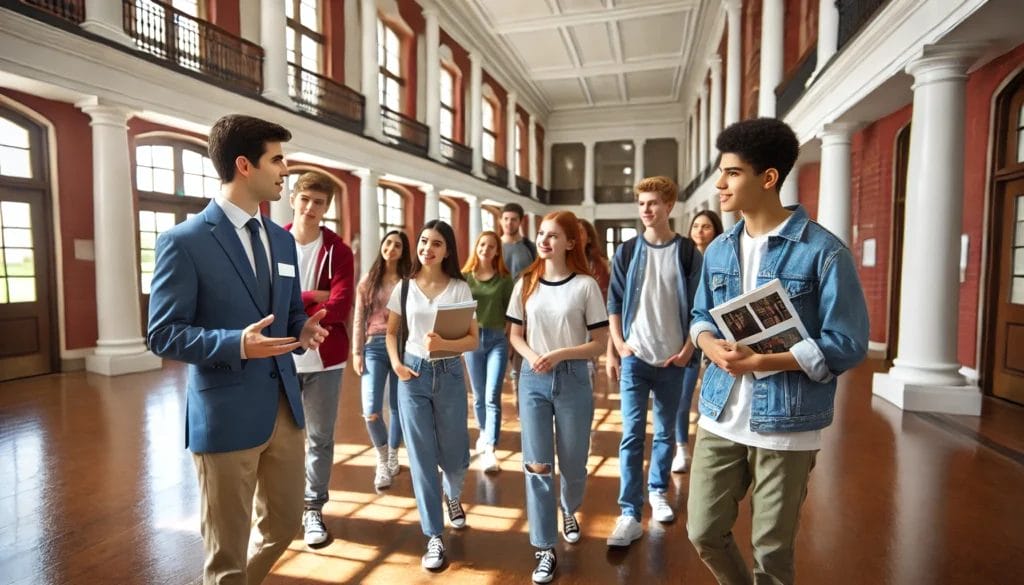Prospective students are people looking into schools and programs to reach their academic goals and plan their futures. They help shape schools and society by pushing for new ideas and inspiring the next generation. To choose the right path, they explore their interests, visit campuses, and join info sessions to learn more.
Who Are Prospective Students?

Prospective students are individuals exploring educational opportunities that align with their goals and aspirations.
They may include high school seniors preparing for graduation, professionals seeking career advancement, or families evaluating excellent learning environments for their children.
These individuals are filled with hope, curiosity, and determination as they navigate significant decisions about their futures.
Aspiring learners come from diverse backgrounds but commonly exhibit traits like readiness for new challenges, a desire to learn, and a drive to succeed.
They seek institutions that resonate with their values, whether through rigorous academics, fostering innovation, or providing environments that promote personal growth.
For educational institutions, understanding what these future-focused learners need is critical.
Many are gearing up for competitive job markets, striving toward ambitious career goals, or aiming for admission to prestigious programs.
Their aspirations push schools to design adaptable and forward-looking curricula that align with the demands of today’s dynamic world.
By pursuing their visionary education goals, these individuals inspire schools to cultivate the leaders and problem-solvers of tomorrow.
Why Prospective Students Matter to Education
Prospective students play a key part in shaping what education looks like and how it impacts the world.
By choosing schools that align with their goals, they inspire schools to improve and adapt to changing needs.
These students aren’t just participants in the system—they actively contribute to its progress through their decisions and engagement.
Educational institutions that respond to these expectations become innovators in the field.
Prospective students help shape how schools develop programs, integrate technology, and provide extracurricular opportunities.
Their commitment to learning fosters an environment where quality education thrives.
On a broader scale, these students represent the foundation of a well-equipped generation poised to address future challenges.
Whether solving global issues or driving technological advancement, their education sends ripples of positive change throughout communities.
Schools that emphasize essential skills—like critical thinking, creativity, and global awareness—are best positioned to support this visionary education.
Ultimately, prospective students are the driving force behind educational progress.
They challenge schools to not only evolve but also excel, ensuring a future filled with potential and innovation.
How to Start Your Journey as a Student
Starting as a prospective student can feel overwhelming, but with some planning, it can be exciting.
The first step is to do your homework.
Look for schools that match your interests, hobbies, and goals.
Check out their websites, read about their programs, and research their offerings to ensure they align with what you’re looking for.
Then, think about what you love to study.
Are you into science, art, or business?
Narrowing down your interests makes it easier to find programs that suit you.
Focus on schools that promote hands-on learning through engaging opportunities that encourage creativity and problem-solving.
It’s also key to build connections.
Talk to admissions counselors, attend virtual events, and connect with student representatives to gain insight.
Hearing about campus life and academic expectations can help you make informed choices.
Being prepared and curious is a significant part of getting ready.
Stay organized and explore schools that inspire visionary education and motivate you to think beyond the present.
Every step moves you closer to finding a place where you can grow and achieve your goals.
Start now. Your future is waiting.
Why Campus Visits Matter for Prospective Students

Ever heard the saying, “You have to see it to believe it?” That couldn’t be truer when picking a school.
For prospective students, visiting a campus in person is a game-changer.
It’s the best way to go beyond what you see in brochures or online.
When you walk the halls, tour the classrooms, and meet the people, it brings it all to life.
You’ll get a feel for the school’s vibe, energy, and culture—things you just can’t fully grasp through a screen.
Often, that real-life connection makes all the difference in choosing the right place to enroll.
Campus visits also give you a chance to ask questions, see how life works day-to-day, and imagine yourself thriving there.
Research suggests that those exploring visionary education options often feel more confident about their choices after seeing schools in person and are more likely to stick with their decision.
Whether it’s seeing advanced labs, checking out the fitness facilities, or even grabbing lunch in the dining hall, these moments can solidify those “gut feelings.”
They’ll give you clarity and help you choose the school where you’ll succeed both academically and socially.
Exploring the Benefits of Info Sessions for Prospective Students
Attending info sessions for prospective students is an excellent opportunity to learn about a school’s culture, academics, and values firsthand.
These sessions offer valuable insights through interactions with faculty, staff, and even current students, giving you a fuller picture that goes beyond what’s available online.
Typically, info sessions feature a combination of talks, campus highlights, and Q&A segments.
Faculty and admissions representatives often showcase what makes their school unique, such as standout programs or their approach to addressing modern educational needs.
This is the perfect time to ask meaningful questions about topics like academics, extracurriculars, or resources for navigating today’s challenges.
The Q&A portion, in particular, is an invaluable component.
It allows you to engage in direct conversations, pose specific inquiries, and receive authentic replies.
Additionally, meeting individuals in person can help you envision yourself as part of their community and better evaluate whether the school aligns with your academic and personal goals.
Ultimately, info sessions go beyond simply delivering information — they empower you to make an informed decision about the next steps in your educational journey.
Schools that host these events demonstrate a commitment to helping prospective students while fostering a shared vision for visionary education.
Figuring Out Your Admission Chances
Getting accepted starts with knowing what matters most in admissions.
For prospective students, key factors include grades, extracurricular activities, and personal essays.
Each piece helps schools see your overall potential, so smart planning is essential.
Checking specific school requirements can make applying easier.
Many schools provide tools and resources on their websites to help applicants navigate the process.
These can show how well you align with a program and highlight areas for improvement.
Using resources like counseling services can also make a big difference.
For those seeking a visionary education, getting clear on requirements and understanding where you stand is the first step to acceptance.
Whether you’re looking at local schools or applying abroad, prospective students who know their chances are better equipped to make smart, strategic plans.
Financial Planning for Prospective Students

Figuring out how to pay for school can feel like a lot, but good planning can make it easier.
Prospective students should start by looking into scholarships.
Many schools offer scholarships based on merit, need, or specific programs to help with tuition.
Explore options from schools, national groups, and local organizations that provide financial aid.
It’s also important to understand tuition and fees.
Ask each school for a clear cost breakdown.
This may include tuition, housing, meals, books, and other potential charges.
Schools sometimes also share estimates for personal expenses to help families plan more effectively.
If additional assistance is needed, financial aid can help cover what scholarships don’t.
Make sure to fill out the Free Application for Federal Student Aid (FAFSA) if you’re in the U.S., and check if schools require any additional forms.
Other options such as work-study programs or payment plans could also help manage costs.
Think about the long-term as well.
Aspiring students should research typical earnings in their chosen field and factor that into loan repayment plans.
Consulting financial planning tools or working with advisors can assist you in making informed decisions, so you can focus on building your future with less financial burden.
With the right approach and a visionary education mindset, paying for school becomes a manageable and rewarding step toward a brighter future.
How Prospective Students Can Make the Most of Dual Enrollment
Dual enrollment gives high school learners a head start on college.
It’s a way to earn college credits early, cut down on the time needed to finish a degree, and build valuable academic skills.
Besides saving time, it also helps these future college-goers adjust to the challenges of college courses, which boosts both their learning and personal growth.
For prospective students seeking a smooth shift into college life, dual enrollment can be a big help.
These programs often provide access to skilled professors and advanced resources, allowing participants to experience college-level education early.
It also looks great on applications, showing their ability to handle rigorous coursework.
In some educational systems, schools may even offer dual admission programs.
These allow learners to seamlessly transition into multiple stages of their education while tailoring their paths to their goals.
Using dual enrollment empowers students to explore potential careers and gain confidence in their studies early on.
It’s a forward-thinking step that aligns with the goals of a visionary education and prepares them for success in today’s competitive world.
Apply Like a Pro: Tips for Prospective Students Applying to Their Dream School
Applying to your dream school can feel like a lot, but it doesn’t have to be stressful.
A strong application can help you stand out and get closer to the Visionary Education you’re aiming for.
Here’s how to do it right:
Watch Out for Common Mistakes
A big mistake many applicants make is turning in incomplete applications or missing instructions.
Admissions teams want to see that you can follow directions, so check everything twice before submitting.
Also, don’t use a one-size-fits-all personal statement.
Show why you’re a great fit for that specific school.
Nail Your Personal Statement
Your personal statement is where you can shine.
Use it to show who you are, your goals, and what drives you.
Instead of listing achievements, tell a story about a challenge you faced and how it helped you grow.
Be honest and real—authenticity always wins over fluff.
Stay on Top of Deadlines
A checklist or calendar can make a big difference.
Use one to track deadlines, forms, and interviews so you don’t miss anything important.
Taking the time to stay organized and thoughtful gives Prospective Students the best shot at getting accepted—and makes the process easier.
Accepted Students: What Comes Next
Congrats! Getting into your chosen school is a big deal—it’s the payoff for all your effort.
Now it’s time to get ready for the next step: moving from an accepted student to an active part of your new school.
This stage is all about getting prepared, making connections, and seizing this chance.
First, carefully go through your acceptance materials.
These usually have key info about deadlines for enrollment, housing, and selecting your classes.
Missing anything could put your spot at risk, so make a checklist to stay on track.
Next, get ready for orientation.
It’s not just a box to check—it’s your chance to learn how the campus works, meet professors, and connect with other prospective students.
Take part in the activities, ask lots of questions, and familiarize yourself with the resources that can help you succeed.
After orientation, work on building your class schedule.
Look into course options, talk with academic advisors, and aim for a mix of challenging and manageable classes.
Additionally, plan your campus life—handle housing, gather necessary supplies, and ensure you’re ready to start strong.
This is just the start.
With a focus on visionary education and personal growth, your path to learning, growth, and new experiences begins now.
Build Your Network as a Student
Making connections can make a huge difference for prospective students trying to succeed in school and beyond.
Talking to current students, alumni, or faculty can give you tips and guidance that you won’t find anywhere else.
Starting something new is always easier when you can learn from someone who’s already been there.
They can provide helpful advice on campus life, challenging classes, and how to make the most of your time from day one.
Start simple.
Join online groups or forums set up by the school or student clubs.
Many institutions offer virtual communities where you can connect with peers.
When you join virtual events or webinars, asking thoughtful questions can help you engage in meaningful conversations.
You can also attend events such as open houses or alumni panels.
Alumni often share their experiences and how their visionary education helped them achieve their goals, offering inspiration and practical advice for your own journey.
Whether it’s a quick chat, sending an email, or following someone on professional networking platforms, every connection helps build a community that supports you.
Your network isn’t just for making friends—it’s a valuable resource for your future.
Start now—those connections can make a lasting impact!
Shaping the Future: How Prospective Students Can Make a Difference

Prospective students today have the power to shape tomorrow.
They’ll influence industries, challenge old ways of thinking, and create innovative solutions we can’t yet imagine.
By choosing educational opportunities that focus on forward-thinking learning, they set themselves up to lead and solve global problems with creativity and grit.
Institutions that emphasize this kind of education go beyond just teaching facts.
They help students learn to think critically, adapt to change, and make ethical choices.
With programs centered on teamwork, innovation, and leadership, these environments prepare graduates to succeed in a world that’s constantly evolving.
For prospective students, aligning with programs or schools that prioritize a future-focused mindset is key.
It’s not just about earning certifications or degrees—it’s about gaining skills to truly make a difference.
From hands-on STEM opportunities to activities that promote global awareness, these programs empower participants to set bold goals and work toward them.
By embracing visionary education and forward-thinking educational paths, students aren’t just building their own futures—they’re contributing to societal progress.
They’re turning big ideas into reality and shaping the world, step by step.
FAQs
Prospective students should look at things like programs offered, activities outside of class, campus vibe, location, class size, and available support. Checking the school’s mission and values can also help determine if it matches their own goals.
Yes! Campus visits let prospective students experience the school firsthand. They can explore the facilities and get a feel for the environment, which helps them make an informed decision.
Before info sessions, prospective students should research the school, prepare specific questions about classes, campus life, and admissions, and take notes during the session to capture important details.
Students can focus on maintaining good grades, showcasing leadership skills, and crafting strong personal statements. Setting clear academic goals can also help them stay on track.
Students can explore scholarships, grants, work-study opportunities, and financial aid packages. Early preparation increases their chances of securing support.

Responses